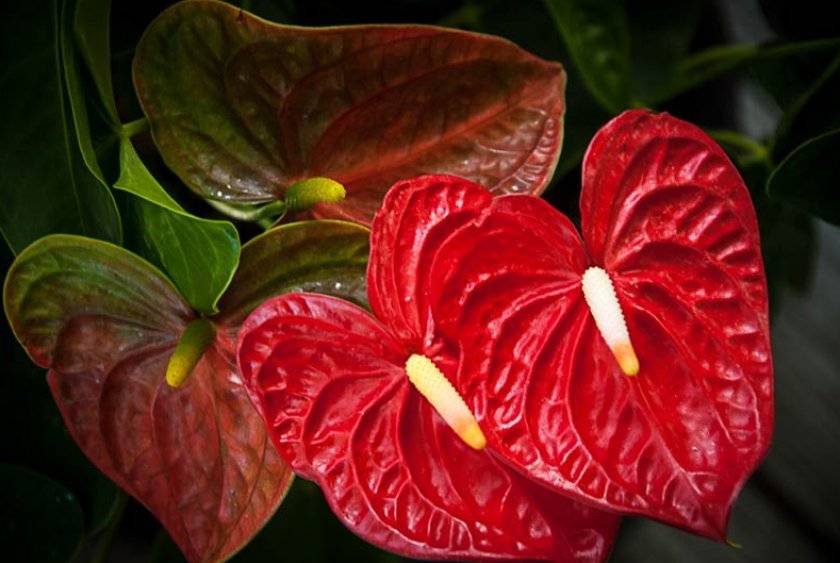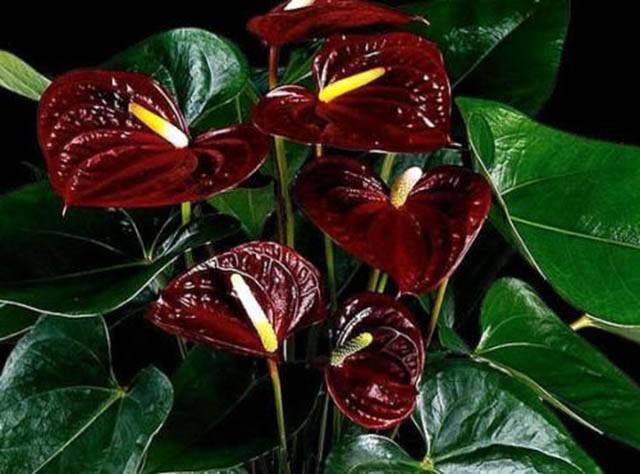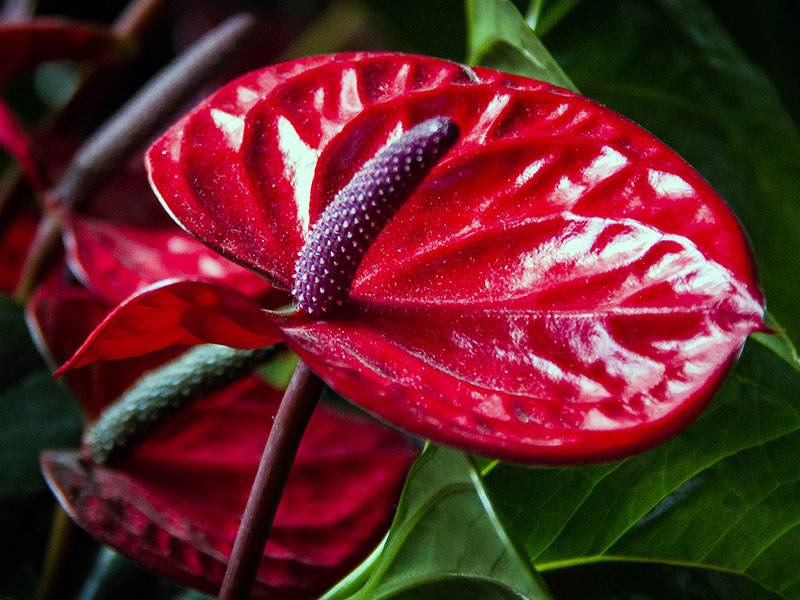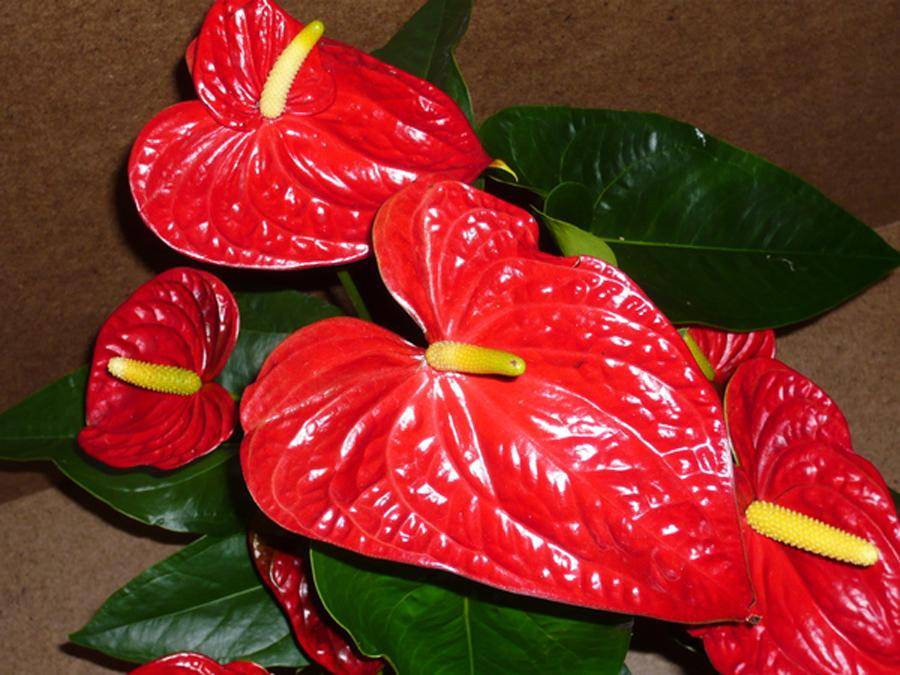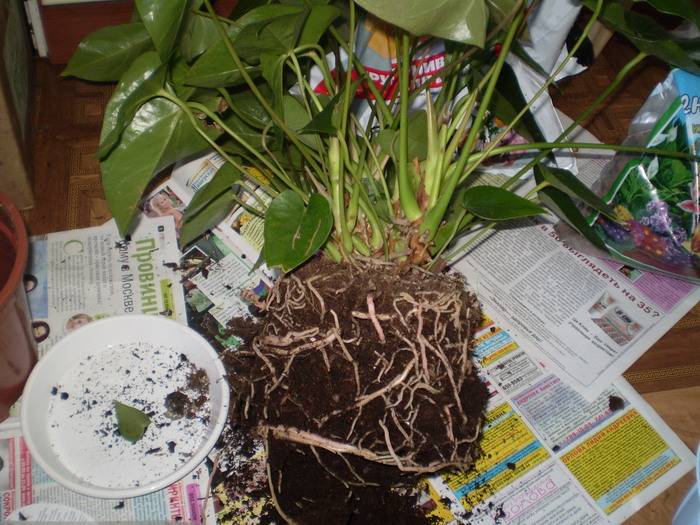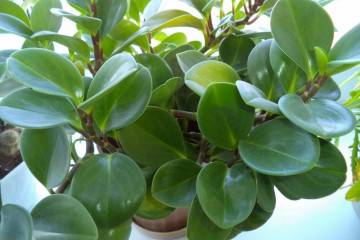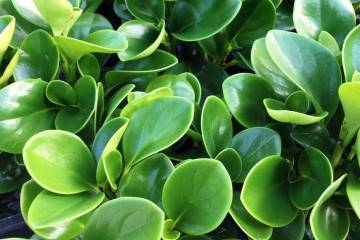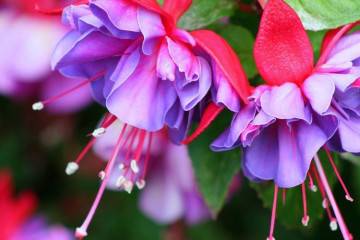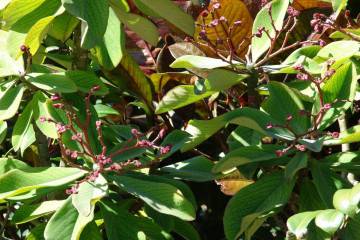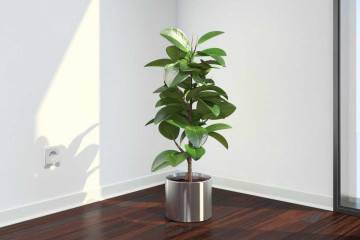Anthurium - home care after purchase
Content:
Anthurium (family Aroid) - native to the tropical jungles of Central and South America. It grows in the form of an epiphyte on trees, the aerial roots of the plant descend to the soil surface. The growing conditions in the wild explain the peculiarities of care when growing a flower as a home plant.
Anthurium - home care after purchase
When purchasing a plant, you need to familiarize yourself with the rules for its cultivation. Anthurium is capricious when leaving, requires special lighting and humidity conditions, needs a specific soil.
Temperature
In summer, the plant prefers an air temperature of + 20-28 ° C. In winter, anthurium needs a dormant period, at this time the temperature in the room should be + 15-20 ° С. Compliance with this condition is necessary for the establishment of flower buds. In higher winter temperatures, the plant will not prepare and will not bloom.
Lighting
Home care for an anthurium flower involves growing the plant in high light conditions, without direct sunlight. Ultraviolet rays lead to burns of leaf plates, can lead to the death of the plant. The best place to grow a flower is with windows facing east or northwest. In winter, during a short daylight hours, anthurium can be placed on the south window.
Watering
Anthurium should be watered with clean, settled water without impurities. In summer, the frequency of watering is once every 3-4 days. In winter, the amount of watering is reduced to once a week.
Spraying
In summer, on hot days, and in winter, when the heating makes the air drier, the flower needs daily spraying. The procedure is carried out using a spray bottle, the water should be at room temperature. When spraying, moisture should not get on the inflorescences, on which dark spots may appear. In hot weather, you can wipe the leaves with a damp cloth.
Humidity
For the good development of the anthurium flower, home care includes maintaining an air humidity of 70-80%. At the same time, the plant does not tolerate stagnant moisture in the pot and pallet. In a constantly humid environment, the roots begin to rot.
Measures to create the necessary microclimate:
- Install a device to humidify the air next to the plant.
- A container with water is placed next to the plant.
- The top layer of soil is covered with sphagnum moss, which absorbs excess moisture, increases moisture near the plant
- The pan of the pot is filled with pebbles or expanded clay, which absorbs excess moisture.
The plant grows well on windows in bathrooms, where water vapor creates conditions favorable for its growth.
Priming
Anthurium roots need a lot of oxygen. Therefore, the soil for the plant should be light, well aero- and permeable. Additionally, holes are made on the sides of the container with the plant for additional aeration of the roots.
The plant prefers a slightly acidic substrate with an acidity of 5.5-6.5 pH.Flower shops sell specialized primers for different types of indoor plants. For anthurium, soil for azaleas, saintpaulias, begonias is suitable.
You need to create additional lightness of the soil by adding perlite or vermiculite, charcoal. It is good to add 10-20% orchid soil to the soil mixture.
Top dressing
Anthurium needs regular feeding during the growing season. From March to October, the plant is fed once every two weeks with complex mineral fertilizers in low concentration. The alternation of mineral and diluted organic dressings is allowed.
Features of care in winter, the dormant period of Anthurium
Winter is a responsible period for a flower. With proper care at this time, buds are laid for spring and summer flowering. The plant should be at rest. It is necessary to stop fertilizing, reduce the frequency of watering to 1 time per week. The water should be soft, you can use melted snow.
The air temperature in the room should not exceed 18 ° C. It is important to maintain the required humidity, which can be difficult with central heating. Daily spraying can handle the problem.
The plant should be inspected to exclude the appearance of pests. In winter, anthurium is often attacked by a spider mite.
When and how it blooms
Most species of anthurium bloom throughout the growing season - from March to November. There are several varieties that bloom in winter. Depending on the variety, the flowering period lasts from a few days to 4 weeks. After a short break, new flower stalks appear. With proper care, anthurium can bloom all year round.
Types of flowers
The various flowering varieties differ significantly in appearance. Each flower consists of a cob and a colorful coverlet (bracts), which gives the plant a decorative effect. Anthurium produces flowers on peduncles 30-40 cm long. All flowers are bisexual, four stamens rise from the perianth.
Kinds of flowers:
- Andre - is distinguished by a large white or red blanket, an ear up to 15 cm long.
- Scherzer - red bracts, scarlet ear, spiral shape.
- Minnesota is a red bracts, during flowering the color of the cob changes: initially white, it gradually turns green.
- Dar Red - a crimson-burgundy bedspread, a red ear.
Flower shapes
Epiphyte anthurium flower consists of cob and bracts. The veined leathery bedspread has a wide variety of colors: white, green, red, crimson, burgundy. The shape of the cob is: clavate, conical, spiral, spherical. The ear has a disc-shaped stigma.
Flowering period
The flowering of anthurium has its own characteristics. First, the ear with the stigma is advanced - the flower is in the female phase. The stamens are hidden under the veil. Drops of viscous liquid appear on the stigma, attracting pollinating insects.
After a few days, the stigma dries up, the stamens stretch out and the flower becomes masculine. To obtain seeds, use a soft brush to transfer pollen from a male flower to a female one.
How to make anthurium bloom
Reasons why anthurium does not bloom:
- the flower was not dormant, flower buds were not formed;
- lack of light;
- drafts;
- frequent rearrangements;
- drying out of the soil.
You can make the epiphyte bloom using the following techniques:
- raise the room temperature above 20 ° С;
- increase the illumination of the plant;
- feed the flower with fertilizers containing phosphorus;
- observe the regime of watering and air humidity.
Pruning anthurium
Aging specimens become less attractive. Their leaves die off, the trunk becomes bare, leaves and flowers shrink. The pruning procedure rejuvenates the plant.
Procedure:
- cut off the upper part of the stem 13-15 cm with aerial roots;
- choose a small pot with drainage holes, fill a third with vermiculite;
- plant the top, cover with vermiculite on top 5 cm;
- make a mini-greenhouse, put it in a lighted place;
- after 1-1.5 months, plant a flower in a permanent place.
How anthurium reproduces
Reproduction of the epiphyte is possible in several ways: by dividing the bush, by seeds, by cuttings, by air layers.
Germinating seeds
Seed propagation pays off when you need to grow a large number of young seedlings. The process is time consuming and takes a lot of time. Subsidiary plants often do not retain the properties of the parent hybrid; it is not known with what color of inflorescences the seedling will grow.
To obtain seeds, artificial pollination is used, which is carried out for 5-8 days to ensure the result. In place of the inflorescence, from 2 to 20 berries are tied, which ripen for 8-12 months. Ripe fruits are kneaded, small seeds are extracted, disinfected in a solution of potassium permanganate.
The optimum temperature for seedlings is + 22-25 ° С. The first shoots appear in two weeks. Saplings dive in the phase of the first true leaf. Seedlings are planted in separate pots when they reach a height of 5-7 cm. Young plants bloom in 1.5-2 years.
Rooting cuttings
Cutting is the most common type of flower reproduction. A stalk is a leaf cut with a part of the stem 5-8 cm long. The planting material is taken from the mother plant, the cut sites are disinfected. The cuttings are dried for 10-15 minutes. Placed for rooting in small pots with sphagnum moss or a mixture of peat chips with sand.
You can root the cuttings in water, which needs to be changed daily. In order for the cutting to give rather roots, a solution of root or heteroauxin is added to the water. The cuttings are closed with a plastic bag to maintain the required humidity and temperature, not lower than + 25-28 ° C. Airing is arranged every day.
Root buds appear in a week. After a month, the seedlings can be planted in small pots with a diameter of 10 cm in soil suitable for an adult plant.
Air layering
Anthurium can be propagated by rooting side shoots (aerial layers). Children are separated during transplantation. Prepare small pots filled with a mixture of sphagnum moss, humus and perlite. Layers with small roots are treated with a biostimulator, planted to a depth of 2-3 cm.Using a polyethylene film, they equip a mini-greenhouse, maintaining t + 28-32 ° C and a humidity of 85%. Arrange daily ventilation.
Other options
The method of reproduction by dividing the bush is suitable for plants over 3-4 years old. This procedure allows you to simultaneously rejuvenate the flower.
Procedure:
- water the bush the day before;
- remove the flower from the pot, shake off the substrate from the roots;
- gently spread the roots, being careful not to damage their fragile structure;
- cut off dark dead areas, sprinkle the cut with crushed coal;
- divide the epiphyte into 2-3 bushes;
- choose pots that are small in diameter;
- plant plants, having buried the roots sufficiently;
- water abundantly.
Anthurium transplant
The flower must be transplanted immediately after purchase. The substrates that are in the pot for sale are not suitable for growing the plant at home.
Step-by-step instructions for the correct transplant:
- Select a suitable container of small size.The pot should be slightly larger than the one in which the anthurium grew. When planted in a large container, the plant spends all its energy on root growth, does not bloom. The soil sour easily. The pot should be wide but shallow. The flower has a superficial root system.
- The plant should be watered abundantly 1-2 days before planting
- Expanded clay is laid at the bottom of the pot as drainage. Expanded clay absorbs excess moisture during watering, then gradually releases moisture to the plant.
- The flower is removed from the pot by tapping lightly on the sides. With the help of a stick, remove as much of the old substrate as possible. This is done carefully, taking care not to damage the fragile root system. Wound surfaces are powdered with crushed charcoal.
- The roots of the flower are soaked for 2 hours in a solution of heteroauxin (1/2 tablet per 2.5 l of water).
- Prepare the substrate: mix the soil with perlite or vermiculite. Add charcoal, pieces of bark or finely chopped sphagnum moss. The soil should be light, crumble in hands.
- A small layer of soil is poured over the expanded clay layer.
- Place the plant in a pot. The correct planting depth should be 1 to 2 cm deeper than the plant grew earlier.
- Very carefully tamp the soil from above so that there are no air spaces between the roots.
- Water the plant at the root, trying not to soak the foliage.
- To make the anthurium easier to endure the stress during transplantation, it is sprayed with Epin's solution (8 drops per 1 liter of water).
Anthurium is an indoor flower with showy inflorescences and shiny attractive leaves. Knowing how to properly care for the anthurium, you can achieve that the plant decorates the house with its flowering all year round.
